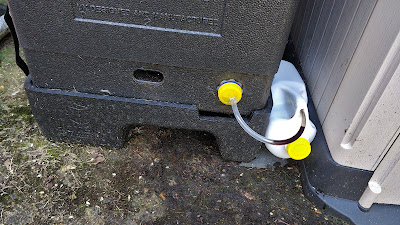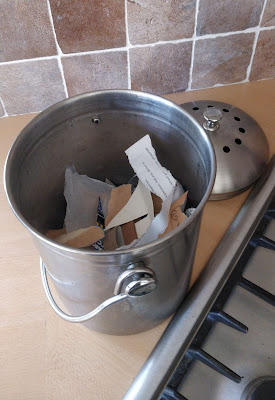We are now proud owners of a hot-bin composter.
I didn't know anything about this a few weeks ago.
But I'm now a bit of a hot-compost fundi.
My wife spotted this thing and just had to buy one.
 |
| the Hotbin Mini (100 litre) |
The idea is that you can 'feed' it with all your kitchen waste and some of your garden stuff; e.g. grass cuttings, weeds, prunings & so on.
Its only a 100 litre container, so it won't swallow all the garden waste, but it stops kitchen waste from going in the land-fill dustbin.
The idea is that waste is composted at a relatively high temperature; typically between 40-60'C in the presence of air (i.e. aerobic composting). This heat is generated by the bacteria that sets about digesting your waste.
There are 2 thermometers with this system. The one in the lid shows the internal air temperature...
...and there is another that you can insert into the compost to get a better idea of compost temperature...
...which unfortunately we have already lost!
Heat is retained in the bin due to its construction using EPP (expanded polypropylene). Composting will take place at lower temperatures, but for meat, fish and cooked food waste the advice is to keep the temperature high.
It is important to keep air flowing through the bin. Air enters at the base of the bin and flow is controlled via a flap in the lid...
The instructions say that this flap should be opened by 2mm. This made no sense when I first set the bin up ...and it still doesn't!
I treat this flap like the control on our woodburner, and have opened it up to raise the temperature. The height of the flap is currently about 10-12mm above the top surface of the lid. If/when the temperature exceeds 60'C I'll simply close it down a little.
Almost everyday we feed the bin with the contents of our kitchen compost caddy; mostly fruit & vegetable peel, with some fish, meat & chicken waste. The caddy is then cleaned and we add a few handfuls of cut-up pieces of absorbent cardboard and strips of absorbent paper.
This may look a lot, but it soon squashes down with the weight of kitchen waste.
The compost bin produces a lot of water, so the paper & cardboard is there to soak it up and bulk up the contents. This is to avoid the contents becoming too wet and blocking airflow; if the process turns from aerobic to anaerobic, the contents will start to smell real bad!
This hotbin has a fluid collection point which should be drained into a container and diluted with water to act as a simple fertilizer (mixed 1:10 parts water).
Unfortunately the sump only has a capacity of around 0.5litre. Beyond this level the fluid starts to escape via the air vent. This is definitely a problem when you go away on holiday if there is no one around to drain the fluid every other day. In our case the fluid runs on to the concrete section of our patio, which could attract the attention of vermin.
Before our last holiday I fitted the bin with an external reservoir...
 |
| The Mk 1 external storage tank! |
...which worked, but didn't have quite enough capacity. The old milk bottle saved about 2litres (probably about 5-6 days worth) and some fluid was lost. But by the time we got back, the HotBin had cooled right down and the rate of fluid production was very low.
So my next idea will probably involve a bigger bottle, and I may raise the bin stand on bricks so that the larger bottle will slide under the stand.
Of course this is all very well, but we've yet to see any compost (...although the liquid fertilizer has been very useful). This HotBin composter should be able to produce "mulch grade" compost in 30 days or "rich organic" compost in 90 days.
By the end of this month it would have been running for more than 2 months and I will open the front and take a look inside. As this is the first load, I'm expecting some un-digested material at the bottom, particularly woody twigs, which will have to be fed back in.
But as for useful compost, we will see in just a couple of weeks!
One other benefit of running this HotBin is that we put much less waste in both our landfill and recycle bins, so now these bins generally only get put-out for collection once a month (...but please don't tell our local council). The recycle bin has less in it because we use packaging cardbord and much of our paper waste in the HotBin. We now put virtually no food waste in the landfill bin, so it doesn't get smelly and can be left until its fuller than before. (Admittedly, there are only 2 of us in this household).
Further reading:-




No comments:
Post a Comment